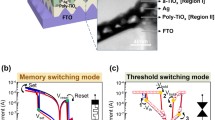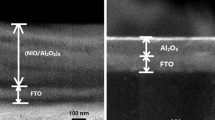Abstract
Resistive switching behaviors in Aloe vera films are being explored for nonvolatile memory applications. A simple structure in which the Aloe vera films sandwiched in between a top and bottom electrode are used. The switching behaviors of the devices in which the Aloe vera film is dried at different temperatures and the roles of top electrode materials (Al and Ag) are investigated. Current density–voltage measurements reveal that filamentary conduction is the dominant conduction process inducing resistive switching characteristics in Aloe vera films. Device with Al-top electrode requires a forming voltage higher than devices with Ag-top electrode, due to the tendency of oxide formation of these materials. The resistive switching behaviors are highly reproducible, as demonstrated by the data retention performance over an interval of 104 s and endurance capability of over 100 cycles.
Similar content being viewed by others
References
S. Bauer and M. Kaltenbrunner, ACS Nano 8, 5380–5382 (2014).
M. Irimia-Vladu, Chem. Soc. Rev. 43, 588–610 (2014).
S. Mühl and B. Beyer, Electronics 3, 444–461 (2014).
N. Savage, IEEE Spectrum 52, 18 (2015).
E. R. Rodríguez, J. D. Martín and C. D. Romero, Crit. Rev. Food Sci. Nutr. 50, 305–326 (2010).
A. G. Volkov, J. C. Foster, E. Jovanov and V. S. Markin, Bioelectrochemistry 81, 4–9 (2011).
L. Q. Khor and K. Y. Cheong, J. Mater. Sci. Mater. Electron. 24, 2646–2652 (2013).
L. Q. Khor and K. Y. Cheong, ECS J. Solid State Sci. Technol. 2, P440–P444 (2013).
A. G. Volkov, J. Reedus, C. M. Mitchell, C. Tucket, V. Forde-Tuckett, M. I. Volkova, V. S. Markin and L. Chua, Plant Signaling Behav. 9, e29056 (2014).
W. F. Lim, H. J. Quah, S. Sreenivasan and K. Y. Cheong, Mater. Technol. 30, A29–A35 (2015).
Z. X. Lim and K. Y. Cheong, Phys. Chem. Chem. Phys. 17, 26833–26853 (2015).
Y. Ko, Y. Kim, H. Baek and J. Cho, ACS Nano 5, 9918–9926 (2011).
H. Baek, C. Lee, K.-I. Lim and J. Cho, Nanotechnology 23, 155604 (2012).
M. K. Hota, M. K. Bera, B. Kundu, S. C. Kundu and C. K. Maiti, Adv. Funct. Mater. 22, 4493–4499 (2012).
N. Gogurla, S. P. Mondal, A. K. Sinha, A. K. Katiyar, W. Banerjee, S. C. Kundu and S. K. Ray, Nanotechnology 24, 345202 (2013).
K. Nagashima, H. Koga, U. Celano, F. Zhuge, M. Kanai, S. Rahong, G. Meng, Y. He, J. De Boeck, M. Jurczak, W. Vandervorst, T. Kitaoka, M. Nogi and T. Yanagida, Sci. Rep. 4, 5532 (2014).
Y.-C. Chang and Y.-H. Wang, ACS Appl. Mater. Interfaces 6, 5413–5421 (2014).
N. R. Hosseini and J.-S. Lee, ACS Nano 9, 419–426 (2014).
Y.-C. Chen, H.-C. Yu, C.-Y. Huang, W.-L. Chung, S.-L. Wu and Y.-K. Su, Sci. Rep. 5, 10022 (2015).
N. R. Hosseini and J.-S. Lee, ACS Appl. Mater. Interfaces 8, 7325–7332 (2016).
X.-J. Zhu, J. Shang and R.-W. Li, Front. Mater. Sci. 6, 183–206 (2012).
D. R. Lide, CRC Handbook of Chemistry and Physics, 84th ed. (CRC Press, Bota Raton, FL, 2004) ch. 8, pp. 23–28.
T. Oyamada, H. Tanaka, K. Matsushige, H. Sasabe and C. Adachi, Appl. Phys. Lett. 83, 1252 (2003).
M. Cölle, M. Büchel and D. M. de Leeuw, Org. Electron. 7, 305–312 (2006).
F. Verbakel, S. C. J. Meskers, R. A. J. Janssen, H. L. Gomes, M. Cölle, M. Büchel and D. M. de Leeuw, Appl. Phys. Lett. 91, 192103 (2007).
T. Kever, U. Böttger, C. Schindler and R. Waser, Appl. Phys. Lett. 91, 083506 (2007).
Author information
Authors and Affiliations
Rights and permissions
About this article
Cite this article
Lim, Z.X., Sreenivasan, S., Wong, Y.H. et al. Effects of Electrode Materials on Charge Conduction Mechanisms of Memory Device Based on Natural Aloe Vera. MRS Advances 1, 2513–2518 (2016). https://doi.org/10.1557/adv.2016.522
Published:
Issue Date:
DOI: https://doi.org/10.1557/adv.2016.522




